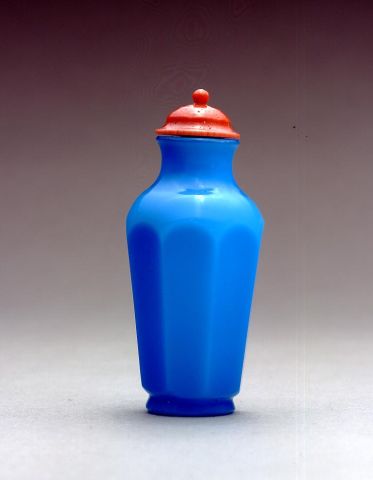
Bottle ID: 00465
TURQUOISE, OCTAGONAL, FACETED PANELS
Date: 1720-1796
Height: 56 mm
Glass, of small meiping form, with eight vertical faceted panels ending at the rounded shoulders which ascend to an everted lip, and with a splayed flat foot, of opaque bright turquoise tone.
Imperial, attributed to the Palace Workshops, Beijing.
Similar Examples:
Crane Collection no. 444.
Hui, Humphrey K. F., Margaret Polak and Christopher C. H. Sin. Hidden Treasures of the Dragon - Chinese Snuff Bottles from the Collections of Humphrey K. F. Hui, Margaret Polak, Christopher C. H. Sin, 1991, p. 125, no. 255.
Christie's, New York, March 21, 2002, lot 5, The Blanche B. Exstein Collection.
Provenance:
Robert Hall
Asian Art Studio
Joseph Baruch Silver
Exhibited:
Annual Convention ICSBS Toronto, October 2007
Published:
Lawrence, Clare. 1993 Chinese Snuff Bottle Engagement Diary, 1992
The Crane Collection houses a considerable number of faceted monochrome glass bottles of various forms. This bottle is taken from a classical meiping ceramic shape to which the technique of faceting has been added. The resulting form, however, does not look forced and the bottle imparts an agreeable charm.
Turquoise has been valued as a precious stone in many different cultures including China. It was transported along the Silk Road with other precious stones such as malachite. The Chinese have mined turquoise domestically for more than three thousand years, since at least the Shang dynasty. In later times, Marco Polo reported that turquoise could be found in what is today known as Sichuan province. While the eighteenth century Chinese preferred a bright blue-turquoise known as "Robins-egg blue" (as jewelers today also do); the Tibetans placed a higher value on a more greenish hue.
< Back to full list
 English
English 中文
中文